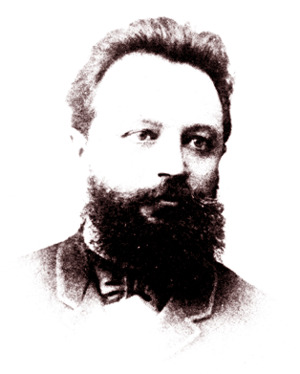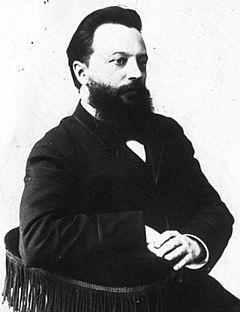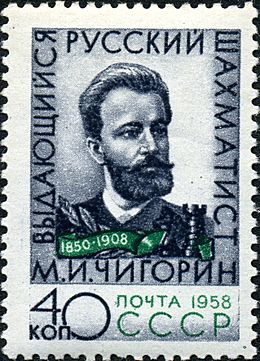Mikhail Chigorin facts for kids
Quick facts for kids Mikhail Chigorin |
|
|---|---|
 |
|
| Full name | Mikhail Ivanovich Chigorin |
| Country | Russian Empire |
| Born | 12 November 1850 Gatchina, St. Petersburg Governorate, Russian Empire |
| Died | January 25, 1908 (aged 57) Lublin, Congress Poland, Russian Empire |
Mikhail Ivanovich Chigorin (born November 12, 1850 – died January 25, 1908) was a famous Russian chess player. He played two matches for the World Chess Championship against Wilhelm Steinitz. Chigorin was known for his exciting and creative "Romantic" style of chess. He also greatly inspired the "Soviet chess school", which became very strong in the chess world during the 1900s.
Contents
Early Life and Chess Beginnings
Chigorin was born in Gatchina, a town in Russia. Sadly, his parents died when he was young. At age 10, he went to an orphanage in Gatchina. He learned to play chess at 16 from his schoolteacher. However, he didn't become serious about the game until around 1874, after he finished his studies. He first worked as a government officer.
Becoming a Chess Professional
Once Chigorin fell in love with chess, he quit his job. He decided to become a professional chess player. In 1876, he started his own chess magazine called Chess Sheet. He edited this magazine until 1881. Soon, he was seen as the best player in his city and perhaps all of Russia.
Chigorin's International Chess Tournaments
Chigorin played in his first international tournament in Berlin in 1881. He finished in third place, which was a great start. This tournament included 17 top chess masters.
Major Tournaments and World Championship Matches
At the big London tournament in 1883, he finished fourth. This event had 14 of the world's best players. In 1889, he tied for first place at a strong tournament in New York. After this success, he challenged Wilhelm Steinitz, the World Champion, for the title.
Their first World Championship match was in Havana in 1889. Chigorin lost this match. A second World Championship match also took place in Havana in 1892. Chigorin lost this one too, but it was a very close fight.
Chigorin had a very close record against Steinitz overall. They even played a special "telegraph match" in 1890. This match was set up to settle a chess idea debate. Chigorin won both games in this unique match.
Later Successes and Rivalries
As the 1800s ended, Chigorin was considered one of the top four or five players in the world. He drew a match with Siegbert Tarrasch in 1893. He also had a good record against Tarrasch, who was a very strong player.
One of his best performances was at the Hastings 1895 chess tournament. He finished second, even ahead of the World Champion Emanuel Lasker. All the greatest players of that time were there. Chigorin even beat Harry Nelson Pillsbury, who won the tournament.
In other big competitions, he shared first place at Budapest in 1896. He also finished well at Cologne in 1898 and Monte Carlo in 1901.
Gambit Play and Russian Championships
Chigorin was very good at playing chess openings called gambits. These are openings where a player sacrifices a pawn early to gain an advantage. He won the King's Gambit tournament in Vienna in 1903. He also beat Lasker in a special Rice Gambit tournament. Chigorin was also a master of the Evans Gambit, which he used in many games against Steinitz.
Besides international events, Chigorin won the first three All-Russia Tournaments. These wins in 1899, 1900/01, and 1903 proved he was Russia's best player.
Chigorin's Unique Chess Style
Chigorin's playing style was very creative. He was excellent at finding clever tactical moves. He didn't always agree with the strict rules that other masters like Tarrasch and Steinitz taught. However, he did agree with Steinitz about having a strong center in chess.
He also helped develop new ideas in openings like the Ruy Lopez and the Slav Defence. Chigorin was described as a handsome man with a large beard.
His Demeanor During Games
Frank Marshall, another chess player, once said that Chigorin would get very nervous during difficult games. He would tap his feet and cross his legs. Sometimes, he would become "a bundle of nerves" and his mood could turn "quite fierce."
Later Life and Legacy
Chigorin was a great representative for Russian chess. He gave many lectures and wrote articles for magazines and newspapers. He also supported chess publications to help them continue. He even started a chess club in Saint Petersburg. He worked for years to create a national chess association, which finally happened after his death.
In 1907, Chigorin did not play well in a tournament. He was not healthy. Doctors told him he had severe diabetes and only a few months to live. He returned to his family in Lublin and passed away in January 1908. After his death, many "Chigorin Memorial" chess tournaments were held in his honor.
Founding the Soviet Chess School
Many Russians see Mikhail Chigorin as the founder of their "School of chess", later known as the Soviet School of Chess. His original talent, exciting games, and teachings greatly influenced Russian chess. Even though new ideas came along in the 1920s, Chigorin's impact was very important for the Soviet Union's chess success in the 20th century.
Chess Openings Named After Chigorin
| This section uses algebraic notation to describe chess moves. |
Several chess openings or variations are named after Chigorin. The two most important are:
- The Chigorin Variation of the Ruy Lopez (1.e4 e5 2.Nf3 Nc6 3.Bb5 a6 4.Ba4 Nf6 5.0-0 Be7 6.Re1 b5 7.Bb3 d6 8.c3 0-0 9.h3 Na5 10.Bc2 c5 11.d4 Qc7). This opening has been popular for a long time.
- The Chigorin Defence to the Queen's Gambit (1.d4 d5 2.c4 Nc6). This defense became more popular recently, thanks to players like Alexander Morozevich.
Chigorin also invented another opening line in the French Defence: 1.e4 e6 2.Qe2.
See also
 In Spanish: Mijaíl Chigorin para niños
In Spanish: Mijaíl Chigorin para niños



